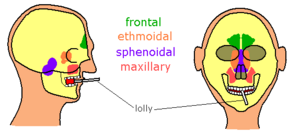Paediatric respiratory infection
Upper respiratory
This is stuff affecting the nasal cavaties and pharynx, as detailed on their respiratory pages.
Snotty little kids, whinging away...
Having a cold and a sore throat is pretty much the definition of childhood, so you will see a lot of these. Usually a cold is a rhinovirus, sore throat an adenovirus. There’s no point in treating with antibiotics cos they won’t work. If they have a fever, give them some paracetemol. That’s about it.
The sore throat may be caused by streptococcal infection in school age kids. The pharynx will be inflamed. Tell them to get over it.
Tonsillitis
Inflamation of the tonsils. Look for an ‘exudate’ (spots of pus on it). Usually caused by strep, or its adenovirus. Generally the child with the bacterial infection will be more ill. That said, antibiotics are usually given, even though only about a third of the them are non viral. When screening for rheumatic fever, its worth asking about episodes of tonsillitis. In patients with recurrent episodes, tonsillectomies are common, since taking it out stops the itis.
Pharyngitis (sore throat)
This is the common sore throat. Usually caused by group A Streptococcus. Paracetamol for a few days should make things better. Bow selector!
Acute otitis media
Ear infection cause by Pneumococcus and group A Streptococcus. Not really respiratory, but very linked in kids. Again, mega common. If any child has a fever, the tympanic membranes must be examined, since it may be bright red. Generally, the pain will go away with some paracetemol and the child will be better in a couple of days.
Sometimes, recurrent episodes leads to chronic secretory otitis media, which is the main cause of conductive hearing loss in children. Insertion of ventilation tubes called grommets to prevent hearing loss is currently under debate; it is probably not very useful.
Epiglottitis
This one is, thanks to the Hib vaccine, rare in the UK. Since the Haemophilus influenzae type b infection is systemic, the child will have a fever, and clearly be ill. They will have a rapidly increasing respiratory distress, with body posture to maximise airways, and a sore throat that prevents the child from talking.
The very first thing you must do is contact the anaesthetist and ENT surgeon. This is so the anaesthetist can intubate and, if that fails, the surgeon can do a tracheostomy (put a hole in the throat). Also, do not go anywhere near their throat, because you may force the airway to close; the anaesthetist needs to be on hand to intubate. If the airway closes they can die, but if you protect it, they should respond to antibiotics (usually a cephalosporin like ceftriaxone or cefotaxime) and make a full recovery.
Respiratory airways
The epiglottis is the marker of the beginning of the airways. They run from below it, the larynx, down the trachea and through the bronchi and bronchioles.
Croup
This is also known as viral laryngobronchotracheitis. One day, when you have a child, it will awake at 3 am, and then start coughing with a barking sound, and crying. For several nights in a row. And good news - 1 in 20 2 year olds get it. Hits between 6 months and 6 years. It's caused by parainfluenza viruses, or a few other similar ones.
Listen for a characteristic barking cough, in more severe cases accompanied by stridor. If the child at rest has a stridor, worry a little. As with all obstructive airway disease, the smaller the child is, the less 'spare' airways they have, so a small inflammation can be disastrous; in babies, be more aware. And don't miss epiglottitis, since the presentation can be very similar.
Bronchiolitis
This is the most common cause of a wheezy chest in babies. It's basically due to viral infection in the bronchioles (very small airways) from RSV (respiratory syncitial virus). There is rather a grey area in diagnosis of this condition. Basically, its a bit like asthma, but its not chronic. And its like viral (which is itself like asthma), but it doesn't respond to bronchodilators. So pretty much, if you have a wheezy baby that doesn't respond to bronchodilators, its probably bronchiolitis.
Management is basically oxygen when needed. It is not usually really serious, but as said before, babies have small airways, so a little obstruction causes a big problem.
Viral wheeze
As said, viral wheeze is basically a wheeze, brought on by inflammation of the small airways due to a virus. Unlike bronchiolitis, it responds to bronchodilators, such as salbutamol. Whereas asthma is due to allergy, viral wheeze is due to a virus. There is a lot of cross-over though, so don't worry too much.
Lungs
Pneumonia
Pneumonia is always a serious condition. There are three main groups that are affected:
- newborn - usually beta-haemolytic Streptococcus.
- infancy - RSV, or Strep. pneumoniae.
- children - bacterial becomes much more common, and its usually Mycoplasma pneumoniae
They present with fever, cough, shortness of breath and tiredness. Breathing will often be quick and shallow. Chest Xray is important, since in children other signs can be variable.
All children should be given antibiotics, as it can be difficult to determine whether it is viral or bacterial. If there is a pleural effusion, it needs to be drained, and the child may need to be supported with oxygen.
